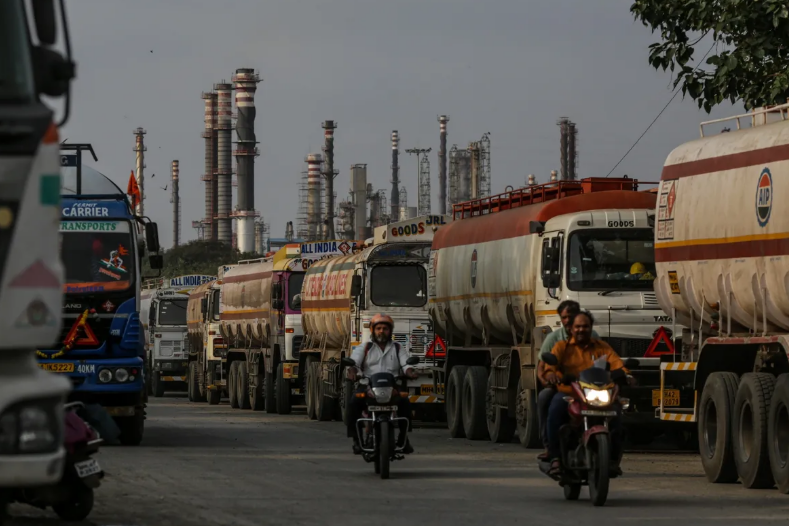
Indian refineries seek urgent outputs after a US threat of surcharge and European blockade to diesel derived from Russian oil
India’s oil refineries are being forced to rethink their supply strategies in the face of an unprecedented offensive by the United States and the European Union against Russian energy flows. Movement places New Delhi in a delicate position, forcing its largest companies in the sector to look for alternatives in an increasingly competitive and geopolitically unstable market.
India, which has become one of the leading Russian oil buyers in recent years, is now facing a significantly stricter posture of both Washington and Brussels. US President Donald Trump intensified pressure by publicly criticizing energy and Russian armaments across Asian, announcing that the US would apply an import tariff of 25% over Indian products from this Friday.
Read too
USA attack Chinese terminal and acir oil war
Family Mode Transforms Tiktok into children’s mirror
Powerdate shows that 46% blame the Bolsonaro family for tariff
The commercial threat arrived at a time when Indian state refineries were already beginning to feel the effects of European restrictions. The European Union had already signaled its intention to prohibit the importation of diesel produced in India from Russian gross oil – a measure that promises to directly impact the profitability of Indian companies in the European market.
Given this scenario, companies such as Indian Oil Corp., the country’s largest oil processor, have accelerated their efforts to diversify supply sources. Last Thursday, the company launched a proposal for purchase with exceptionally short delivery time, aiming at oil scheduled to arrive in late September and early October. The initiative represents a significant change in relation to traditional standards, where this type of supply would normally be forecast of delivery for mid or late October.
The Bharat Petroleum Corp. It also entered the search movement for alternatives, acquiring different varieties of gross oil from the Middle East and West Africa for delivery in the same period. Race by alternative suppliers illustrates the urgency with which Indian companies are trying to adapt to the new geopolitical environment.
The challenge is particularly complex considering India’s historical dependence on Russian oil. According to data compiled by Bloomberg, the country imported about 1.63 million barrels per day of Russian raw last year – more than a third of the total of its energy acquisitions. These volumes have remained stable so far this year, but international pressure begins to demand structural changes.
In addition to political restrictions, Indian refineries face other operational challenges. The reduced availability of Russian oil, combined with the escalation of international prices, has placed additional pressure on the companies’ profit margins. The situation is aggravated by the need for adaptation of industrial processes, as different types of oil require technical adjustments in refineries.
Sector companies are currently seeking Indian government guidance on how their operations will be affected by new international measures. Coordination between Nova Déli and state -owned companies will be crucial to defining the country’s energy strategy in the coming months.
The situation also reflects the growing instrumentalization of energy as a foreign policy tool. While the US and the EU seek to economically isolate Russia, countries like India need to balance their energy needs with the diplomatic pressures of strategic partners.
For experts, the episode demonstrates how global supply chains are increasingly vulnerable to geopolitical tensions. India, traditionally neutral in international conflicts, now needs to navigate carefully between maintaining its access to cheap energy and preserving its western power relations.
Given this scenario, the coming weeks will be decisive to understand how the Indian energy sector will be able to adapt to new geopolitical realities – and it will be able to maintain its competitiveness in an increasingly polarized international environment.
Trump imposes 25% tariff on India and threatens new measures for Russian purchases
US President Donald Trump announced on Wednesday the imposition of a 25% tariff on Indian exports to the United States, starting this Friday. The measure marks another climbing on commercial tensions between the two countries and puts in check New Delhi’s recent efforts to negotiate a bilateral trade agreement.
In a statement on social networks, Trump justified the decision by pointing out the high rates practiced by India – which he classified as “among the highest in the world” – and non -monetary barriers to commerce. The president also vehemently criticized Indian energy purchases and Russian weapons at a time when the international community seeks to press Moscow to interrupt the war in Ukraine.
“In addition, they have always bought the vast majority of their Russian military equipment, and are Russia’s largest energy buyer, along with China, at a time when everyone wants Russia to stop attacks in Ukraine,” Trump wrote. “India will therefore have to pay a 25%rate, plus a fine for the above, from August 1st.”
In a later press conference at the White House, the US president indicated that negotiations with India were still underway. “Let’s see what happens,” he said. “It doesn’t matter much if we come to an agreement or if we charge a certain tariff of them, but you’ll know by the end of this week.”
Trump’s decision comes at a delicate time for relations between the two countries. India had been one of the first Asian nations to start commercial conversations with Washington, especially after the high-child’s high-child visit to White House in February. The parties had already defined terms for a bilateral agreement during a meeting between Vice President JD Vance and Modi in April, committed to complete the understanding by the end of this year.
The Indian government responded to the announcement by stating that it remains committed to “fair, balanced and mutually beneficial” agreement. In a statement, the authorities highlighted the need to protect farmers, entrepreneurs and small businesses, reaffirming that “the government will take all the necessary measures to protect our national interest,” as he has done in other recent agreements, including the UK free trade treaty.
The reaction in the markets was immediate. Indian role plummeted and the stock markets fell after the announcement. Futures of the Nifty 50 index, traded in Gujarat International Finance Tec-City, deleted previous gains and fell up to 0.5%, while local currency fell 0.8% compared to the dollar in the international market, reaching its lower five months in the internal trading session.
“Although commercial negotiations seem to have broken between the two nations, leading to the US to penalize India, we believe that the commercial saga and bargain by the deal are not necessarily ended,” Emkay Global Financial Services Ltd economist said, “there is also a global geopolitical angle in these negotiations that goes beyond the purely economic aspect.”
Trump’s stance represents a significant change compared to the early months of the year, when the Modi government adopted a conciliatory approach, reviewing its tariff structure and offering commercial and migratory concessions to the United States. Aides of the US President had repeatedly signaled that an agreement with India was near.
However, the tone of negotiations seems to have become more rigid in recent weeks, with New Delhi adopting firmer positions in the face of impasses in sensitive issues such as agriculture. Trump also re -threatening secondary sanctions against countries that continue to buy Russian oil – a warning that can directly affect China and India.
Washington and his allies see these energy acquisitions as a form of tacit support to Moscow, helping to support the Russian economy and weaken the impact of international sanctions. The American decision may further aggravate the already tense relations between the US and India, especially considering that Trump has repeatedly claimed to have used trade as an instrument to mediate four -day armed conflict between India and Pakistan in May – a statement vehemently denied by Modi and other Indian leaders.
The measure can also undermine the US long -term efforts – including previous administration initiatives, including Trump’s first management – to cultivate India as a strategic counterweight to China in the Asian region.
The main Indian opposition spared no criticism of the announcement. Congress leader Jairam Ramesh mocked the approach between Modi and Trump, suggesting that personal relationships did not translate into concrete commercial benefits for India.
The threat of additional tariffs arrives a day after Trump reduces the deadline for Russia to reach a ceasefire with Ukraine to ten days, increasing the possibility that penalties about Russian oil buyers come into force earlier than expected.
India maintains traditional economic and military ties with Russia, avoiding publicly criticizing President Vladimir Putin for the invasion of the Ukrainian neighbor. Since early 2022, India has become one of the largest importers of Russian oil, acquiring more than a third of its total energy purchases from the European country, according to Kpler data. In addition, about 36% of the Indian military arsenal comes from Russia.
This energy dependence concerns analysts, which point out that an abrupt change from suppliers could negatively impact the Indian current account and inflationary expectations, and affect the feeling of local markets. “Changing to new suppliers can have a negative impact on India’s checking account and expectations of inflation, and weigh on the feeling about local markets,” explained Brendan McKenna, an emerging market economist and wells Fargo & Co.
The United States is India’s main commercial partner and its largest export market, with bilateral exchanges reaching $ 128 billion in 2024. New Delhi had unsuccessfully tried to negotiate a limited trade agreement with Washington during Trump’s first term.
The US President has labeled India as a “King of Tariffs” and repeatedly criticized the country’s commercial barriers. According to 2023 data from the World Trade Organization, the simple average fare of India was five times higher than the US and the highest among the main global economies.
“It’s a very asymmetrical situation. I think we hope that India will open its markets for us,” said Kevin Hassett, White House Economic Counselor, in an interview with CNBC. Like agreements with the European Union and Japan, the US seeks access to Indian markets for its companies and farmers.
“And if we could do it in India, it would be an absolute change in the game to the global economy, because it is such a big and growing economy,” Hassett added.
Discord points in negotiations are the US requirement to export genetically modified agricultural crops – something that India refuses to do, alleging risks to its farmers. New Delhi, in turn, has been pressured for exemptions in sectoral tariffs, especially regarding future measures on pharmaceutical products.
The 25% rate imposed on Indian products is significantly higher than rates traded by other Asian countries: 20% for Vietnam, 19% for Indonesia and 15% for Japan. The difference places India at a competitive disadvantage in the US market.
“India export prospects and their investment appeal would be harmed, especially if sectoral exemptions for smartphones and other electronics are eliminated and the basic tariffs of each country are applied,” warned Alexandra Hermann, economist at Oxford Economics in London.
With information from Bloomberg*
Source: https://www.ocafezinho.com/2025/07/31/guerra-do-petroleo-chega-as-bombas-indianas/
